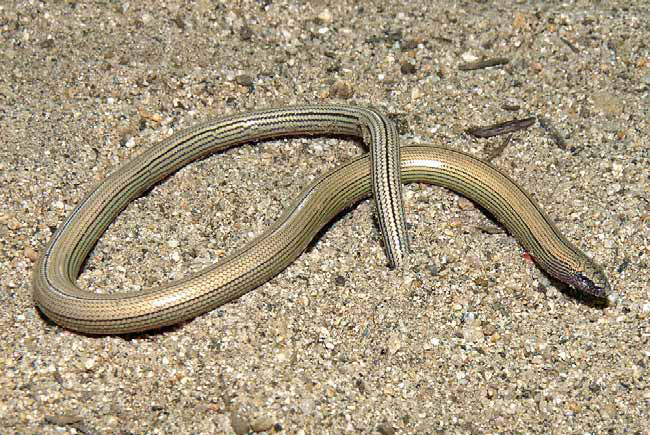UCLA Clinic Submits Amicus Brief in Kern Oil Ordinance Case
Kern County’s efforts to increase drilling could jeopardize the survival of the Temblor legless lizard. The case demonstrates why environmental review must keep pace with emerging science and new information.

The UCLA Environmental Law Clinic has submitted an amicus brief in a case that challenges Kern County’s (the “County”) repeated efforts to streamline oil and gas development without proper regard for myriad environmental harms. The Clinic filed its amicus brief on behalf of Professor H. Bradley Shaffer, Ph. D., one of California’s leading experts on the evolutionary biology, ecology, and conservation biology of amphibians and reptiles. He has published a book entitled California Amphibian and Reptile Species of Special Concern that focuses on amphibians and reptiles determined by the state of California to be Species of Special Concern, like the Temblor legless lizard. This brief explains that the lizard is a small, imperiled reptile that is restricted to a thin sliver of land, found mostly along the County’s western border. The lizard is extremely vulnerable to harms caused by oil and gas development, and harms to the lizard from this project would be exacerbated by the lizard’s extremely limited habitat range.
Professor Shaffer says we need to preserve species like the Temblor legless lizard for two reasons. “First, if we want to maintain a semblance of environmental health and resilience, we need to keep the pieces of the environment intact. The pieces are species,” he says. “And as the Temblor beautifully illustrates, we are incredibly ignorant about the most basic elements of our local ecosystems. Second, it’s the right thing to do. Species take thousands, and more often, millions of years to evolve and populate our planet. Wiping them out for our short-term economic gain is simply wrong.”
Kern is the county with the highest rate of oil and gas activity in the state—producing more than three-fourths of all onshore oil in California. Despite the human health and ecological impacts of oil and gas development, the County has sought to streamline its oil and gas permitting under the California Environmental Quality Act (“CEQA”). In doing so, the County seeks to avoid individualized environmental review for new oil and gas extraction operations, opting instead to produce a single environmental impact report (“EIR”) covering most new drilling for the next 25 years.
After the County’s first attempt at adopting a streamlining ordinance in 2015, California’s Fifth Appellate District ruled that the County had violated CEQA by adopting an inadequate EIR. The County adopted a second, functionally identical ordinance in 2021 (“Ordinance”), purporting to have fixed the flaws in its EIR with a supplemental EIR. But local community groups maintain that the new EIR fails to properly address serious health and environmental concerns raised by the Ordinance, including the County’s failure to mitigate fine particulate matter, a dangerous air pollutant for which the County already is in violation of federal standards; inadequate assessment of the risks of drilling new wells near homes and schools; and failure to mitigate water supply issues. Community groups are further concerned with procedural inadequacies by the County, including failure to provide adequate analysis of the ordinance’s costs and benefits; improper refusal to provide critical information to the County’s Spanish-speaking residents; and critically for this amicus brief, failure to supplement its analysis of the Ordinance’s impacts to the Temblor legless lizard, despite the identification of new information showing more severe impacts to the lizard than were assessed.
Earlier this year, these local community groups and other interested parties challenged the County’s EIR in V Lions Farming, LLC v. County of Kern. After the trial court found the EIR deficient in two respects but upheld the County’s action otherwise, Petitioners appealed the case to California’s Fifth Appellate District. As Hollin Kretzmann, an attorney at the Center for Biological Diversity, one of the group of Petitioners, puts it: “Kern County’s plan to fast-track thousands of new oil and gas wells will jeopardize community health, water availability, and many imperiled species that are clinging to their last remaining habitat.”
Central to the Clinic’s brief is the recent discovery that the Temblor legless lizard is unique to a small strip of land mostly within Kern. This limited habitat range was systematically modeled by a study commissioned and funded by the California Department of Fish and Wildlife in 2019, before the County’s second bite at the apple in 2021. The study demonstrated that contrary to the County’s assumption that the Temblor legless lizard has a large habitat range, the lizard’s range is very small and concentrated in the area where the Ordinance is projected to cause the most intense development. Under CEQA, it is sometimes necessary to reanalyze a project impact in response to substantial new information or changed circumstances. Here, the Clinic’s brief argues that CEQA required the County to reassess the Ordinance’s impacts on the Temblor legless lizard in light of this newly-available scientific research.
This case exemplifies why we need a strong CEQA at a time when the statute is the subject of much debate in Sacramento and beyond. CEQA seeks to both (1) inform the public and governmental decisionmakers about trade-offs in approving a project with environmental effects, and (2) prevent significant and avoidable damage to the environment. Vulnerable critters like the Temblor legless lizard depend on CEQA to require agencies to fully consider and (where feasible) mitigate harmful environmental impacts. It’s common-sense that agencies should not rely on outdated studies when new information about a species like the Temblor legless lizard is available before approving projects that can have dire environmental effects.
And as changes to CEQA are discussed—including, most recently, a slate of bills Governor Newsom signed just this week to speed up review and litigation under the long-standing law—it’s worth keeping in mind how CEQA can be used as an tool for environmental justice communities. Here, community groups have fought for eight years against the County, seeking to prevent or mitigate the health and environmental impacts from further oil and gas drilling in their neighborhoods, using CEQA as a key lever.







Reader Comments